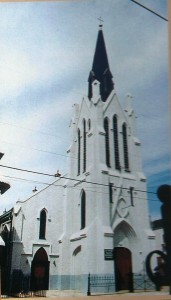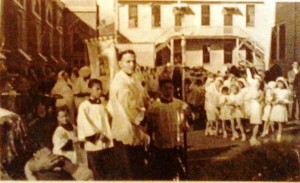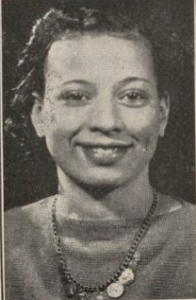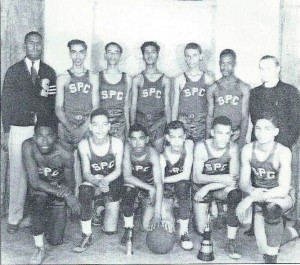
As the bells pealed forth from the stately church on St. Philip Street, hundreds of people crowded inside to witness the dedication of a church they could now call their own. It was Sunday, October 24, 1920 and everyone was anxious to learn the name chosen for their new church and its new pastor. During the 10a.m. Mass they were informed by Archbishop Shaw that no more appropriate name could be given to the newly consecrated church than that of St. Peter Claver since this was the great saint who spent 50 years laboring for the colored race.
It was not a new church building they were dedicating, but one that had been erected in 1852 and had stood for the past 78 years as St. Ann’s Catholic Church. Originally, the Catholic congregation of St. Anne was both black and white, with segregation being practiced within the church. Only white students could attend its school. The white members of the congregation reorganized in 1920 and decided to move to a location on Ursuline Avenue and North Galvez, just a few blocks away as a white parish.
Leaving behind a church, rectory and school consisting of ten lots of land, Father Badeaux, pastor of St. Anne’s wrote a letter to Father Samuel Kelly, S.S.J. suggesting that the Josephites purchase his parish plant for the Catholic colored population.
The Josephites knew there was a great need for another Catholic parish in the downtown area for people of color. Therefore, on April 7, 1920, the property was sold and purchased by the Josephite Society for $32,500. The boundaries of the new parish were set to embrace a portion of Corpus Christi Parish and also a portion of St. Katherine Parish.
St. Peter Claver School
By the next year of 1921, the old St. Anne’s school was completely remodeled by the parishioners and a newly refurbished one opened in the fall. It consisted of two lay teachers, two nuns from the Sisters of the Blessed Sacrament and 150 students in four grades. Each year one grade and one lay teacher would be added until there were eight grades. The children themselves raised enough money to purchase playground equipment and to install a play area on the school grounds. The first graduating class would receive their diplomas after the 8:30 Mass on Thursday, June 9, 1927.
The Apparition (1927)
An unusual event occurred at St. Peter Claver’s School on Saturday, October 1, 1927 when Mrs. Jennie Lombard claimed to have seen an apparition of St. Therese of the Little Flower in one of the windows. As word spread throughout the community, thousands gathered to witness the phenomenon. Such chaos was created until Father Joseph A. St. Laurent, S.S.J. (Pastor) had the window removed, but many said they soon found the same image on two other windows. One witness declared in a daily local paper: “I am a lawyer and I am careful of any public statement I make; but you can use my name, I saw St. Theresa on that window.” Years later, older members recalled seeing the apparition. A statue of the young St. Therese would later be donated to the church by Miss Rose Cheche.
Father St. Laurent (1920-1929)
Father St. Laurent would remain as pastor for nine years (1920-1929). Parishioners remember him as a very effective priest who spoke so simply and directly that all of those listening could understand. Two of his quotes were:
“It is a strange kind of Catholic that parades a new suit for Easter, with all the same old sins under it. Don’t polish the outside only, but cleanse the inside as well.
“Show yourselves intelligent through generosity. Put your right hand into your own pocket before holding out your left for assistance.”
Priest and Parishioners in May Crowning Procession
Under Father St. Laurent’s guidance, parishioners labored endlessly. They established four religious organizations: Society of St. Ann (for women), Holy Name Society (for men), St. Vincent de Paul, and the Parents’ Club. A statue of St. Anthony was donated by Mr. George Blanchard. Stained-glass windows were donated by individuals and groups of parishioners. The altar to St. Ann was donated by the St. Anne Society and a beautiful statue erected and blessed in 1925.
Mrs. Daniska DuConge Cager – First Organist
The first organist was Miss Daniska DuCongé who was followed by Miss Valerie Bowie, Mrs. Frank Boutté, Miss Irene Bowie, and Mr. George Davis.
1930s
By 1934, the school now had enlarged to all 8 classrooms and 550 pupils. A new school was needed but the country was deep in the throes of a major depression. The church was filled at every Mass and 6,000 parishioners were in attendance.
In 1938, a house on St. Philip Street was remodeled, raised, and another floor added. This became the new convent for the 8 nuns now assigned to the school. All labor was done by the tradesmen of the parish.
1940s
In 1941, grounds were purchased for a new recreation hall and school. By 1944 the new three-story brick school building was completed and sports became an integral part of students’ activities.
1945 Basketball Team & Fr. Francis Cassidy, S.S.J.
1950s
By 1953, the parish boast of 11 societies and organizations led by dedicated members who donated untold hours of their time. The Claver Federal Credit Union was founded in 1954. When the parish rectory was damaged by fire in 1953, the parishioners brought gifts of linens, food, house wares, etc. to the priests who were then housed in the old convent.
A large Mardi Gras Parade in 1955 became a tremendous success. There were skating and penny parties, a children’s carnival and a parade with various theme floats. A School for Exceptional Children for the mentally challenged was established and run by Sister M. Claire Francis and later Sister Mary Eustelle.
1960s
By 1964, the Claver Federal Credit Union had passed the $100,000 mark in savings and had established a school savings program for students. One year later, 250 pupils contributed and enrolled as junior members of the NAACP. By 1969, Father John H. Ricard, S.S.J., introduced an Afro-American History course into the curriculum. This was also the year that St. Anne Parish (due to decreased enrollment brought on by white flight) closed and was consolidated with St. Peter Claver.
1970s- 1990s
Throughout the 1970s to mid 1980s, the parish began to see the impact of economic hard times as many of the youth that had been educated in the parish school moved to other New Orleans neighborhoods and cities. This change left the parish with few parishioners and struggling financially.
In August, 1984 the Josephite Society decided to turn over the administration of the parish to the Edmundite Fathers. The Sisters of the Blessed Sacrament left in May of 1986.
1990s- 2000s
Under the leadership of Father Michael P. Jacques (a vocal and influential pastor) and many dedicated parishioners, St. Peter Claver Parish became a beacon of hope in an inner-city community that many had written off as lost to crime and poverty. Many of the young people have returned and the parish has more than 2400 registered families making it one of the largest African- American Catholic Churches in the state of Louisiana.
Sources: Anniversary Booklets for St. Peter Claver, Archdiocese of New Orleans Archives; The Colored Harvest, Josephite Society, Aug/Sept. 1936 Issue p.13 and Jan. 1921 Issue p.4-5; New Orleans Architecture, Vol. 6 p. 191; A History of the Archdiocese of New Orleans, Charles E. Nolan p. 76; The Josephites & the African-American Community State of Louisiana (1897-1997); www.stpeterclaverneworleans.org/history.html
Lolita V. Cherrie






I attended St. Peter Claver Academy (SPCA) in San Antonio under the leadership of the Sisters of the Holy Ghost from approximately 1943-44 till 1954 before moving to Los Angles, and I’m wondering if my school had any connection/afflication with St Peter Claver in New Orleans? SPCA eventually closed, but most, if not all of the nuns remained and went from traditional academic teaching to training young single or soon to be single mothers in skills such as sewing, cooking, infant care, etc. When I would go back to San Antonio as a young adult to visit family, I always made it a responsibility to go and visit the school and the nuns and contribute food and
speak to the young girls under the guidance of the nuns. I always felt a profund sadness, as not only was the school as I knew it closed, but our church where I was baptized; served as an alter boy and studied Latin after school five days a week in order to assist our priest in the Mass. These were some of the happiest times of my entire life and to this day, I
still have nothing but the fondest memories there.
What happened to the establishment of the Knights and Ladies of St. Peter Claver. Why were they not recorded in the 1920’s
Really enjoyed the article. I attended St. Peter Claver (1950-58) along with my 8 siblings. I played basketball, was a patrol boy, an altar boy and worked part time there after high school.
Mr. Gallo, thanks for your comment. Father John H. Dorsey Council No. 50 of the Knights of Peter Claver was established on 21 November 1926. Its principal founder was Joseph Edmond Glapion. The Ladies’ court, Our Lady of Victory Court No. 50, was the first established in the city. It was organized by Sidonia Martinez McCarthy. Please visit CreoleGen again soon!
Mr. Clifton, thank you for your comment! There is no direct association between the two, although they both served Catholics of color, were staffed by the Josephite Fathers, and were both were under the patronage of Saint Peter Claver. You may be interested in knowing that Saint Peter Claver’s in San Antonio was the first church named after him after his canonization. Please visit CreoleGen again soon!
Over and over again, I read of ‘white flight’. And, yet, they considered themselves ‘christian’. It’s a testimony of remarkable integrity on the part of the Creoles of color and black Catholics who, notwithstanding this blatant racism, chose to embrace their Catholic heritage and faith. Too often, the Church’s leaders were compliant with the UNCHRISTIAN conduct of the white majority; precious few among the clergy standing up for what was right, morally and politically.
I grew up in St Peter Claver Parish and attended the school from kindergarten thru 8th grade [1944-1953] and was married there in 1961. I truly enjoyed the wonderful article. It brought back many great memories.
Enjoyed the article !!!
I am Daniska Cager’s oldest grandson. Until today 12/16/14 I never knew my grandmother played the organ. I was aware of her educational achievements, but thought the music was of her brothers’ work. Reading other posts and articles has really shed lite on the history and musical talent of the Duconge family. And I am very proud and happy to see a young beautiful smiling grandmother…. Thank you very, very much!
Mr. Cager, Thank you for visiting CreoleGen. Please continue to visit and spread the word about our site. I am so glad that you were able to learn a bit more about your grandmother. Ernest DuCongé was a very well-known bricklaying contractor and civic leader in the 1910s – 1930s. Would you or someone in the family have a picture of him?
I grew up in St. Peter Claver Parrish and school. So much of my life in the 50’s was spent on that campus. Great memories! I think I am related ,through marriage , to Mrs DuConge Cager.
Hello,
My great, great grandmother, Agnes Terrance died in January 1936. St Peter Claver was her home parish church and her funeral was held there. I have been looking for years for more information about her and her son, Gustave. I was going to ride over from Biloxi, but don’t know if anybody would be at the church or if it would even be open on a random weekday.
Could you share information of a contact who could help me? Thanks so very much.
To: Candi Sims… I spoke to the secretary at St. Peter Claver. They do not have burial information for 1936. You would have to contact the Archdiocese of New Orleans Archival Department. In the meantime, I have researched and found records which may be of importance to you. Agnes ‘parents were Gustave and Priscilla Terrance of Boothville, La. The Agnes Terrance I found was buried from St. Raymond Catholic Church in NOLA and not St. Peter Claver. There is much more, but I will email you personally with my cell # so we can communicate personally. Looking forward to speaking with you and hopefully can be of assistance…..Lolita
thank you, Lolita ! I will contact you tomorrow (Sat Nov 14)
(Actually, the Agnes Terrence you are speaking of is the GRANDAUGHTER of the Agnes I am looking for. Gustave & Pricilla named their daughter after Gustave’s mother. I got my information from the Jan 1936 obituary of Agnes Terrence that her funeral mass was at St Peter Claver and she was buried in Holt Cemetery….her daughter, Edna Corca, was my great grandmother)
Hi,
This is Janet Brown. My entire family attended St. Peter Claver. My youngest brother Wayne Julien was on the basketball team. My sister Lynn and I would take turns covering for Mrs. Boutte playing the organ whenever she was on vacation.
I should have added that my grandmother spoke often of the apparition.